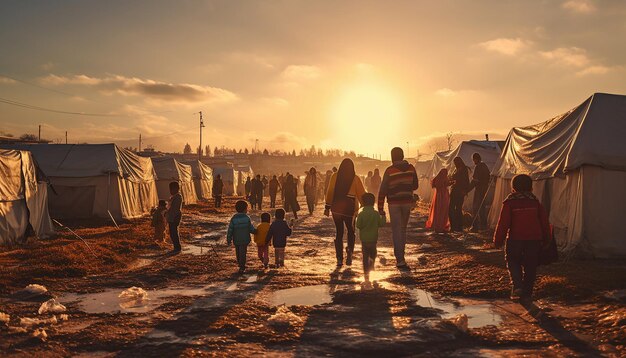US Response to Global Refugee Crisis: Policy & Humanitarian Efforts

The United States addresses the global refugee crisis through evolving policy changes, humanitarian aid, and resettlement programs, navigating complex international dynamics and domestic priorities to offer protection and assistance to displaced populations worldwide.
The global refugee crisis, marked by unprecedented levels of displacement, presents a persistent challenge to nations worldwide. Against this backdrop, understanding how the US is addressing the global refugee crisis: policy changes and humanitarian efforts becomes crucial. This article delves into the multifaceted approach taken by the United States, examining both its evolving policy frameworks and its significant humanitarian contributions.
The Evolving Landscape of US Refugee Policy
The United States has historically played a significant role in international refugee protection, a commitment rooted in both its founding principles and post-World War II humanitarian efforts. However, the exact nature of this engagement has continuously adapted to geopolitical shifts, economic pressures, and domestic political environments. Examining this evolution reveals a complex interplay of idealism and pragmatism, reflecting the nation’s struggle to balance humanitarian imperatives with national interests.
Historical Precedents and Legislative Foundations
The modern framework for US refugee policy largely solidified after the Vietnam War. Before that, refugee admissions were often ad hoc, tailored to specific crises like the Hungarian Uprising or the Cuban Revolution. The Refugee Act of 1980 marked a pivotal moment, establishing a comprehensive and standardized system for refugee admission and assistance based on international law. This act aligned US policy with the 1951 Refugee Convention and its 1967 Protocol, defining a refugee as someone with a well-founded fear of persecution.
* The Refugee Act of 1980: Provided a legal definition of “refugee” consistent with international standards.
* Annual Consultations: Established a process for the President to consult with Congress annually on refugee admissions.
* Resettlement Program: Created a structured program for refugee resettlement within the US, including aid for integration.
Despite these foundations, policy implementation has seen considerable variability. Administration policies, judicial challenges, and public opinion have all contributed to a dynamic and sometimes unpredictable environment for those seeking refuge. The discretion afforded to the executive branch in setting annual caps on admissions often reflects the prevailing political climate, leading to significant fluctuations in the number of refugees accepted.
Recent Policy Shifts and Their Impact
In recent years, the discourse around immigration and refugees has intensified, leading to notable policy shifts. The previous administration, for instance, implemented policies that drastically reduced refugee admissions, tightened asylum eligibility, and introduced measures like the “Remain in Mexico” policy. These changes had profound implications, leaving thousands of asylum seekers in precarious situations and weakening the long-standing infrastructure of refugee resettlement.
The current administration has signaled a renewed commitment to refugee protection but faces the challenge of rebuilding a system diminished by previous cuts and compounded by new global crises. Efforts include raising annual refugee ceilings, reviewing restrictive asylum policies, and increasing processing capacity. However, these initiatives are often met with logistical hurdles, capacity limitations, and ongoing political debate, highlighting the enduring complexity of the issue.
* Increased Refugee Ceilings: A stated goal of the current administration to admit more refugees.
* Review of Asylum Policies: Efforts to roll back more restrictive asylum measures.
* Infrastructure Rebuilding: Challenges in restoring the capacity of resettlement agencies and internal processing.
The policies enacted, whether welcoming or restrictive, have tangible consequences on the lives of displaced individuals. They determine who gains entry, under what conditions, and what support they receive, illustrating the profound power of national policy in shaping global humanitarian outcomes. The US approach remains a critical component of the international response to forced displacement, watched closely by both allies and critics alike.
Humanitarian Efforts and Aid Programs
Beyond its domestic admissions policies, the United States stands as the world’s largest humanitarian donor, providing substantial financial and logistical support to international organizations and non-governmental agencies addressing refugee crises globally. This commitment reflects a recognition that addressing the root causes and immediate needs of displaced populations is vital, regardless of where they seek safety. These efforts span emergency relief, long-term development assistance, and complex diplomatic engagements.
Financial Contributions and International Partnerships
The bulk of US humanitarian aid flows through established international bodies. Organizations like the United Nations High Commissioner for Refugees (UNHCR), the World Food Programme (WFP), and UNICEF receive significant funding from the US to support their operations in refugee camps, transit areas, and host communities worldwide. This funding is critical for providing essential services such as food, shelter, healthcare, education, and protection for millions of displaced individuals.
* UNHCR: Consistently a top recipient of US funding for refugee protection and assistance worldwide.
* WFP: Relies heavily on US contributions to provide food security in crisis-affected regions.
* UNICEF: Receives US support for programs focused on child protection, education, and health in displacement settings.
The effectiveness of this aid is often amplified through partnerships. Working with host governments, local NGOs, and other donor nations allows for a more coordinated and comprehensive response to complex emergencies. These partnerships not only maximize resources but also ensure that aid delivery is culturally sensitive and contextually appropriate, fostering greater community resilience.
Direct Aid and Support for Host Communities
In addition to multilateral contributions, the US also deploys direct bilateral aid and technical assistance to countries bearing the brunt of large refugee populations. Nations like Jordan, Lebanon, Turkey, and Uganda, which host millions of refugees, receive significant US support to manage the strain on their public services, infrastructure, and economies. This support often comes in the form of development assistance aimed at improving local capacity and fostering self-reliance among both refugees and their host communities.
For example, US programs might fund:
* Infrastructure projects to improve water sanitation in refugee-hosting areas.
* Educational initiatives to integrate refugee children into national school systems.
* Vocational training and livelihood programs to enhance economic opportunities for refugees and hosts alike.
These efforts acknowledge that sustainable solutions for refugee crises often require investing in the stability and prosperity of the regions where displaced persons reside, reducing dependence on long-term aid, and fostering environments conducive to eventual voluntary return or local integration. Understanding the comprehensive nature of US humanitarian endeavors reveals a global reach that extends far beyond its borders.
Resettlement Programs and Integration Challenges
The US Refugee Admissions Program (USRAP) is the formal mechanism through which refugees, identified and referred by the UNHCR or a US embassy, can be brought to the United States for permanent resettlement. While a small percentage of the global refugee population, those accepted into USRAP are often among the most vulnerable, lacking viable alternatives for safety or durable solutions in their initial countries of asylum.
The Resettlement Process
The journey to resettlement is arduous and protracted, often taking years to complete. It involves multiple layers of security checks, medical screenings, and cultural orientations. Once approved, refugees are typically matched with one of several non-governmental resettlement agencies operating across the country. These agencies, funded partly by the US government, provide initial reception and placement services, helping refugees navigate their new environment.
Key steps generally include:
* Referral: Begins with a referral from UNHCR or a US embassy.
* Security Vetting: Extensive background checks by various US agencies.
* Medical Screening: Health assessments to prevent the spread of infectious diseases.
* Cultural Orientation: Preparing refugees for life in the United States.
* Sponsorship: Matching with a local resettlement agency.
Upon arrival, agencies assist with securing housing, enrolling children in school, finding employment, accessing healthcare, and connecting with community resources. This initial support is critical for enabling refugees to achieve self-sufficiency and integrate successfully into American society. The challenges are numerous, ranging from language barriers to credential recognition and cultural adjustment.
Integration and Economic Self-Sufficiency
The long-term success of the USRAP hinges on effective integration. Integration is not merely about physical presence but about economic self-sufficiency, social cohesion, and civic participation. Studies consistently show that, given time and adequate support, refugees become net contributors to the economy, establishing businesses, filling labor gaps, and enriching the cultural fabric of their communities.
However, the path to integration is rarely linear. Newcomers often face:
* Language and cultural barriers that hinder employment and social interaction.
* Difficulty transferring foreign credentials and work experience to the US labor market.
* Trauma and mental health challenges from past experiences of persecution and displacement.
* Social isolation and discrimination within their new communities.
To address these challenges, resettlement agencies, local communities, volunteer groups, and state governments play vital roles. Programs dedicated to English language acquisition, vocational training, mental health support, and community mentorship are essential in fostering successful integration outcomes. The commitment to resettlement reflects not only a humanitarian obligation but also an investment in the long-term vitality of American society.
Challenges and Criticisms in US Refugee Response
Despite its significant contributions, the US approach to the global refugee crisis is not without its challenges and criticisms. These often stem from the sheer scale and complexity of forced displacement, the inherent tensions between humanitarian ideals and national security concerns, and the volatile nature of domestic political consensus. Addressing these critiques is crucial for refining future policies and enhancing effectiveness.
Bureaucratic Hurdles and Capacity Limitations
One persistent criticism revolves around the bureaucratic inefficiencies and capacity limitations that often plague the US refugee system. The extensive vetting process, while necessary for security, can lead to agonizingly long waiting periods, leaving vulnerable individuals in limbo for years. Fluctuations in political will and funding also create an unpredictable environment for resettlement agencies, making long-term planning and infrastructure maintenance difficult.
* Slow Processing Times: Lengthy security checks and interviews delay arrivals.
* Erosion of Infrastructure: Reductions in admissions capacity strain the resettlement network.
* Funding Instability: Inconsistent government support impacts agency operations.
These operational challenges often result in a significant backlog of cases, missed opportunities to resettle the most urgent cases, and a diminished ability to respond swiftly to new humanitarian emergencies. Streamlining processes, ensuring consistent funding, and investing in human capital are critical for improving responsiveness.
Balancing Security Concerns and Humanitarian Access
Another recurring tension lies in balancing national security concerns with the imperative of humanitarian access and protection. While thorough vetting is universally accepted as necessary, critics argue that some policies have disproportionately impacted certain groups, like those from Muslim-majority countries, or have created overly broad restrictions that impede legitimate asylum claims. The debate often centers on whether security measures are genuinely risk-based or are driven by political expediency.
Furthermore, critics argue that the focus on border security can sometimes overshadow the need for comprehensive solutions that address the root causes of displacement or provide safe, legal pathways for asylum seekers. Policies that lead to family separation or prolonged detention, for instance, are widely condemned on humanitarian grounds, even if justified by proponents on security or deterrence grounds.
Such criticisms highlight the intricate ethical and practical dilemmas inherent in refugee policy, underscoring the need for transparent, evidence-based decision-making that prioritizes both national security and human dignity. The search for a balanced approach remains an ongoing and contentious process.
Specific Case Studies and Regional Responses
To truly understand the US approach, it’s beneficial to examine its responses to specific refugee crises across different regions. The nature of the American response is often tailored to the geopolitical context, the origin of the displacement, and the specific needs of the affected populations, demonstrating a flexible yet often opportunistic and pragmatic foreign policy.
Syrian Refugee Crisis: A Shifting Approach
The Syrian refugee crisis, one of the largest in recent history, tested the limits of international humanitarian response and revealed the variability of US policy. Initially, the US provided substantial humanitarian aid to Syrians in neighboring countries, funding relief efforts in Turkey, Jordan, and Lebanon. However, its domestic refugee admissions relating to the crisis fluctuated dramatically.
Under the Obama administration, efforts were made to increase the intake of Syrian refugees, albeit slowly, amidst significant domestic debate. The subsequent administration, however, drastically curtailed these numbers, citing security concerns. This stark shift demonstrated:
* The profound impact of domestic political will on refugee admissions.
* The reliance on neighboring countries to shoulder the primary burden of displacement.
* The tension between foreign policy goals (supporting allies) and domestic immigration debates.
The Syrian case illustrates how geopolitical strategy, humanitarian concerns, and national security narratives intersect, often leading to a complex and sometimes contradictory response. The long-term implications for the Syrian diaspora and the region continue to unfold, with the US response playing a significant, if at times inconsistent, role.
Refugee Situations in the Western Hemisphere
More recently, the US has faced increasingly complex refugee and migration dynamics within the Western Hemisphere, particularly from countries like Venezuela, Haiti, and those in the Northern Triangle of Central America. This has led to a different set of challenges, often involving asylum seekers arriving directly at the US southern border.
The response to these flows has involved:
* Border Management: Increased focus on border enforcement, processing, and reception.
* Regional Diplomacy: Engagement with Mexico and Central American nations to manage migration flows and address root causes.
* Humanitarian Aid: Providing assistance to transit countries and countries of origin to stabilize populations.
Unlike overseas refugee situations where individuals are pre-vetted, direct arrivals at the border often trigger complex legal processes, including asylum claims, that fall under different legal frameworks. This has led to debates around detention policies, expedited removal, and the legal right to seek asylum, highlighting the unique challenges of managing displacement closer to home. The US has sought to address the root causes of migration, such as poverty, violence, and corruption in these countries, as a long-term strategy for reducing forced displacement. This dual approach of managing current flows while addressing underlying factors is a significant aspect of its current hemispheric strategy.
Future Outlook and Policy Considerations
The global refugee crisis shows no sign of abating, with new conflicts, climate change impacts, and political instabilities continuing to drive forced displacement. As such, the US role will remain critical, necessitating adaptative policies and robust humanitarian commitments. Looking ahead, several key areas warrant focused attention and potential policy adjustments.
Strengthening International Cooperation and Burden-Sharing
The scale of the global refugee crisis demands a truly international response, rooted in enhanced cooperation and equitable burden-sharing. No single nation can address this challenge alone. The US has a vital role to play in revitalizing multilateral mechanisms, encouraging other wealthy nations to increase their contributions, and fostering collaborative solutions that move beyond ad hoc responses.
Future efforts should prioritize:
* Diplomatic Engagement: Leading efforts to resolve conflicts that create refugees.
* Financial Pledges: Maintaining and increasing humanitarian funding commitments.
* Resettlement Partnerships: Working with other resettlement countries to expand pathways for refugees.
A more coordinated international approach would not only provide greater support to displaced populations but also alleviate the disproportionate burden currently borne by a few host countries, particularly those in developing regions. The US, with its diplomatic leverage and financial might, is uniquely positioned to champion such initiatives and lead by example in fostering a more robust global response.
Addressing Root Causes of Displacement
While providing humanitarian aid and resettlement opportunities are crucial, sustainable solutions to the refugee crisis ultimately lie in addressing its root causes. This involves investing in conflict prevention, promoting good governance, fostering economic development, and combating the impacts of climate change in fragile regions. A proactive approach that addresses these underlying drivers of displacement can prevent future crises and reduce the need for emergency humanitarian interventions.
Policy considerations in this area include:
* Development Aid: Investing in long-term development programs in vulnerable countries.
* Climate Resilience: Supporting initiatives that help communities adapt to climate change impacts.
* Conflict Resolution: Active diplomatic efforts to de-escalate tensions and promote peace.
By shifting focus upstream to preventing displacement, the US can contribute to greater global stability and human security, ultimately reducing the scale of future refugee movements. This requires a comprehensive and integrated foreign policy that links humanitarian assistance with development, diplomacy, and security objectives.
The Role of Advocacy and Public Discourse
The effectiveness of US policy and humanitarian efforts in the global refugee crisis is significantly influenced by public opinion and sustained advocacy. Informing the public, countering misinformation, and fostering empathetic understanding are crucial for maintaining political will and ensuring that policy decisions reflect humanitarian values.
Shaping Public Perception and Understanding
Public discourse around refugees is often complex, sometimes characterized by compassion and at other times by fear or skepticism. Media portrayals, political rhetoric, and community experiences all shape how the issue is perceived. Advocacy efforts play a critical role in providing accurate information, sharing human stories of resilience, and highlighting the positive contributions refugees make to their new homes.
This includes:
* Data-driven Narratives: Presenting facts about refugee vetting, economic contributions, and integration success.
* Personal Stories: Sharing individual refugee journeys to humanize the issue.
* Community Engagement: Showcasing local efforts to welcome and integrate refugees.
By fostering a more informed and nuanced public understanding, advocates can build broad-based support for policies that uphold refugee protection and promote successful integration. This long-term effort is essential for creating a durable pro-refugee environment that transcends partisan politics and short-term crises.
Advocacy for Policy Reform
Beyond public awareness, robust advocacy is vital for pushing for policy reforms that strengthen the US refugee system. This includes lobbying Congress for increased admissions, advocating for fair asylum processes, and pressing administrations to uphold international protection standards. Non-governmental organizations, faith-based groups, legal aid providers, and refugee-led organizations are at the forefront of these efforts.
Advocacy also involves:
* Legal Challenges: Challenging restrictive policies in court.
* Coalition Building: Forming alliances across sectors to amplify impact.
* Grassroots Mobilization: Encouraging citizens to contact elected officials.
The collective voice of advocates helps ensure that refugee policy remains a prominent issue on the national agenda, reminding policymakers of the moral and ethical responsibilities inherent in responding to global displacement. Their efforts are a crucial counterbalance to narratives that might undermine humanitarian values or restrict pathways to protection.
| Key Point | Brief Description |
|---|---|
| 🔄 Policy Evolution | US refugee policy, rooted in the 1980 Refugee Act, constantly adapts to global shifts and domestic priorities, influencing admission numbers and treatment of asylum seekers. |
| 🤝 Humanitarian Aid | As the largest donor, the US provides significant humanitarian funding to international bodies and host countries, supporting essential services and long-term development. |
| ✈️ Resettlement & Integration | The US Refugee Admissions Program facilitates resettlement, with agencies providing critical support for integration, despite facing significant challenges. |
| 🚧 Challenges & Outlook | Challenges include bureaucratic hurdles and balancing security with humanitarian access. Future efforts focus on international cooperation and addressing root causes of displacement. |
Frequently Asked Questions About US Refugee Response
The primary law is the Refugee Act of 1980. This legislation established a standardized system for refugee admission and assistance, aligning US policy with international definitions of a refugee and setting parameters for annual admissions ceilings and resettlement programs within the United States.
The US provides humanitarian aid primarily through financial contributions to international organizations like UNHCR, WFP, and UNICEF. It also offers direct bilateral aid and technical assistance to countries hosting large refugee populations, supporting essential services, infrastructure, and development programs aimed at fostering self-reliance among displaced communities.
The USRAP is the formal mechanism for bringing eligible refugees to the United States for permanent resettlement. Refugees are usually referred by UNHCR, undergo extensive security and medical vetting, and are then matched with resettlement agencies that provide initial support for their integration into American society upon arrival.
Key challenges include lengthy processing times due to extensive vetting, capacity limitations of resettlement agencies, and funding instability. Refugees often face language and cultural barriers, difficulty in credential recognition, and the need for significant support to achieve economic self-sufficiency and full integration into their new communities.
US policy attempts to address root causes by investing in development aid, promoting conflict resolution, and supporting climate resilience initiatives in vulnerable countries. This proactive approach aims to prevent future crises by fostering stability, good governance, and economic opportunities in regions from which people are most often displaced.
Conclusion
The United States navigates the complex and evolving global refugee crisis through a combination of policy modifications, substantial humanitarian aid, and structured resettlement programs. While historical commitments to refugee protection remain foundational, recent shifts underscore the dynamic interplay between humanitarian imperatives, national security concerns, and domestic political landscapes. The challenges are formidable, encompassing bureaucratic hurdles, integration complexities, and the pressing need for global cooperation and burden-sharing. Looking forward, sustained advocacy, a focus on addressing the root causes of displacement, and a commitment to international partnerships will be crucial for the US to continue playing a meaningful and effective role in alleviating the suffering of displaced populations worldwide. A comprehensive approach that balances compassion with pragmatic solutions is essential for building a more stable and humane future.





